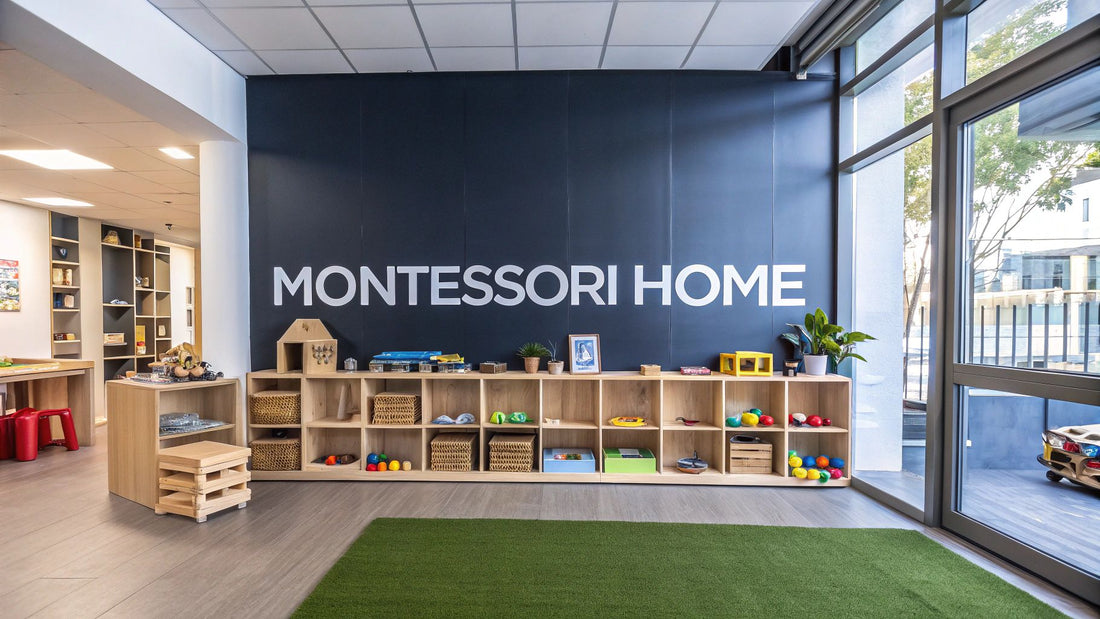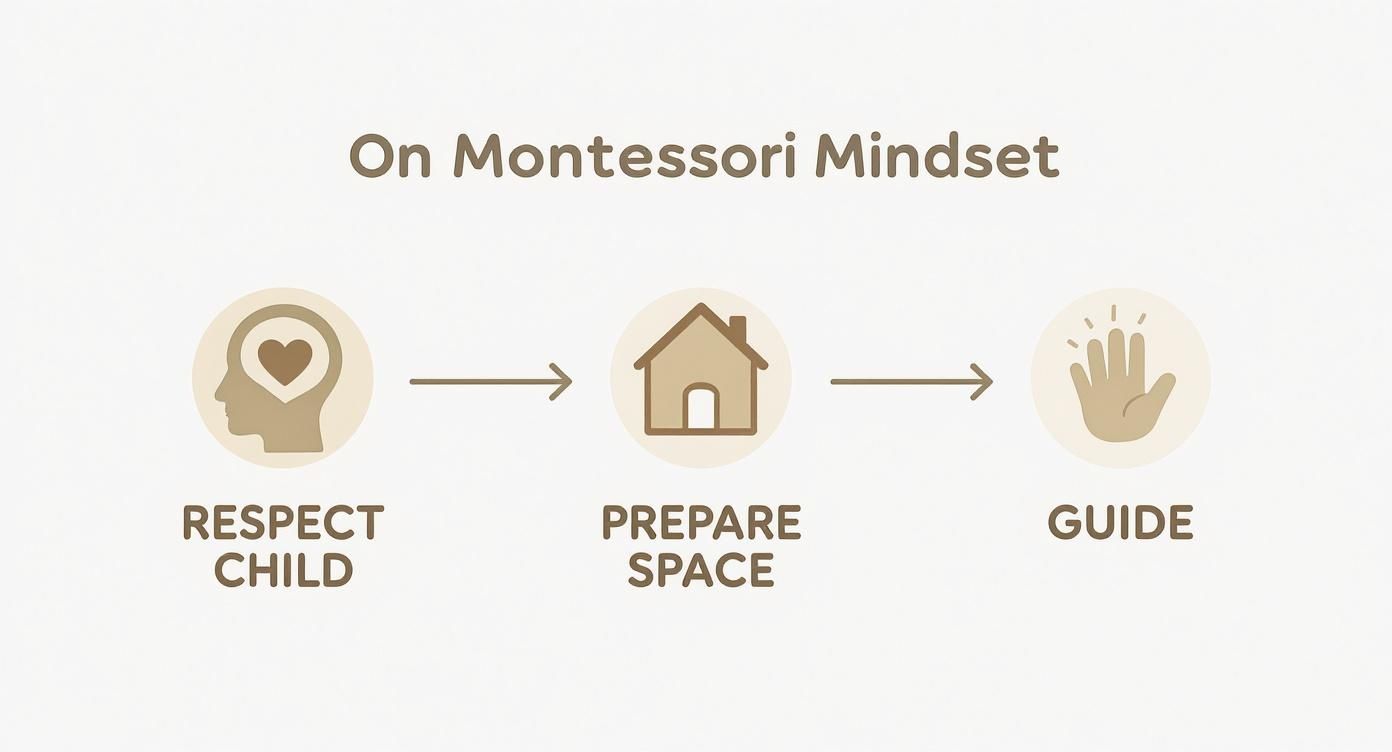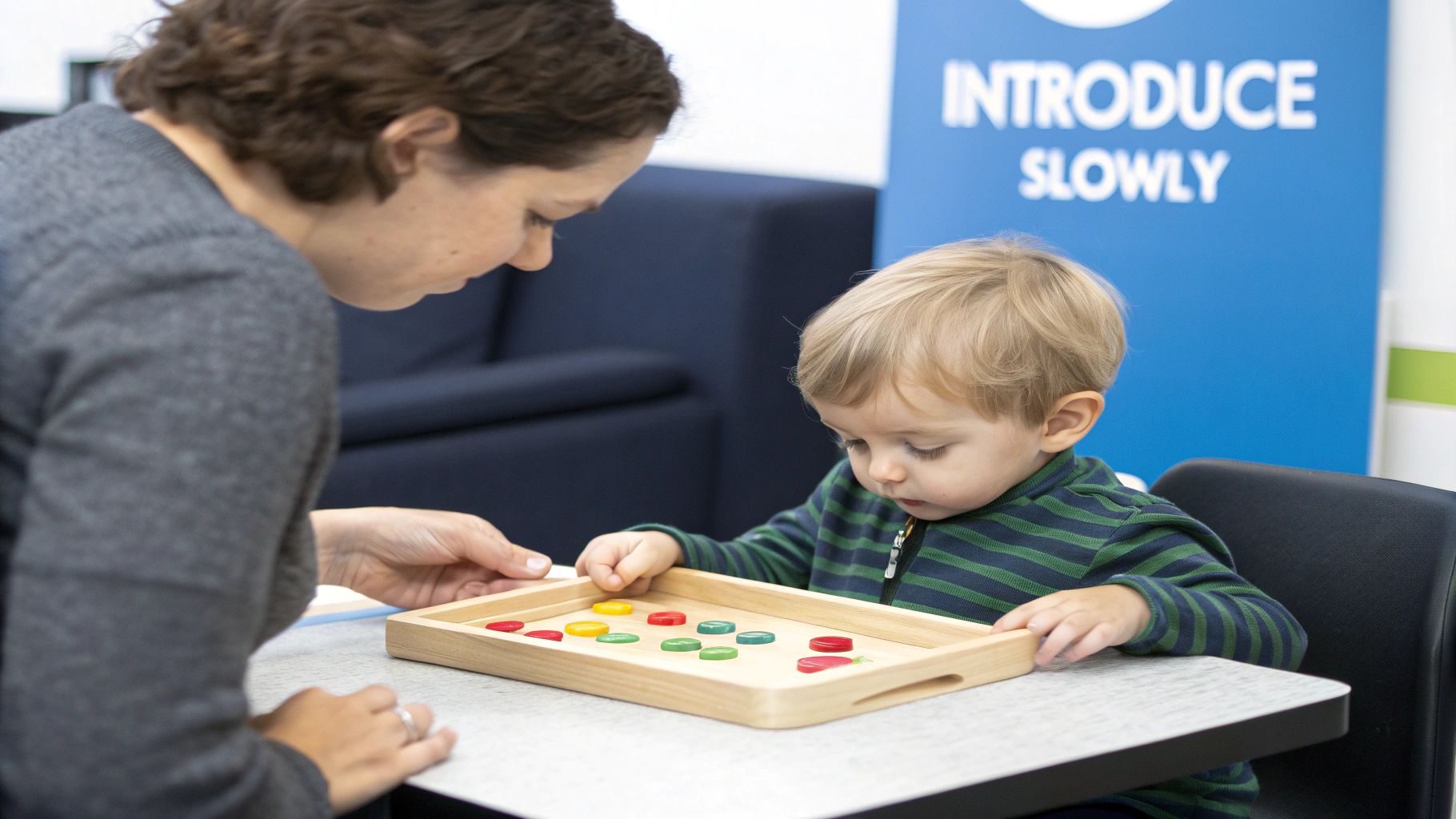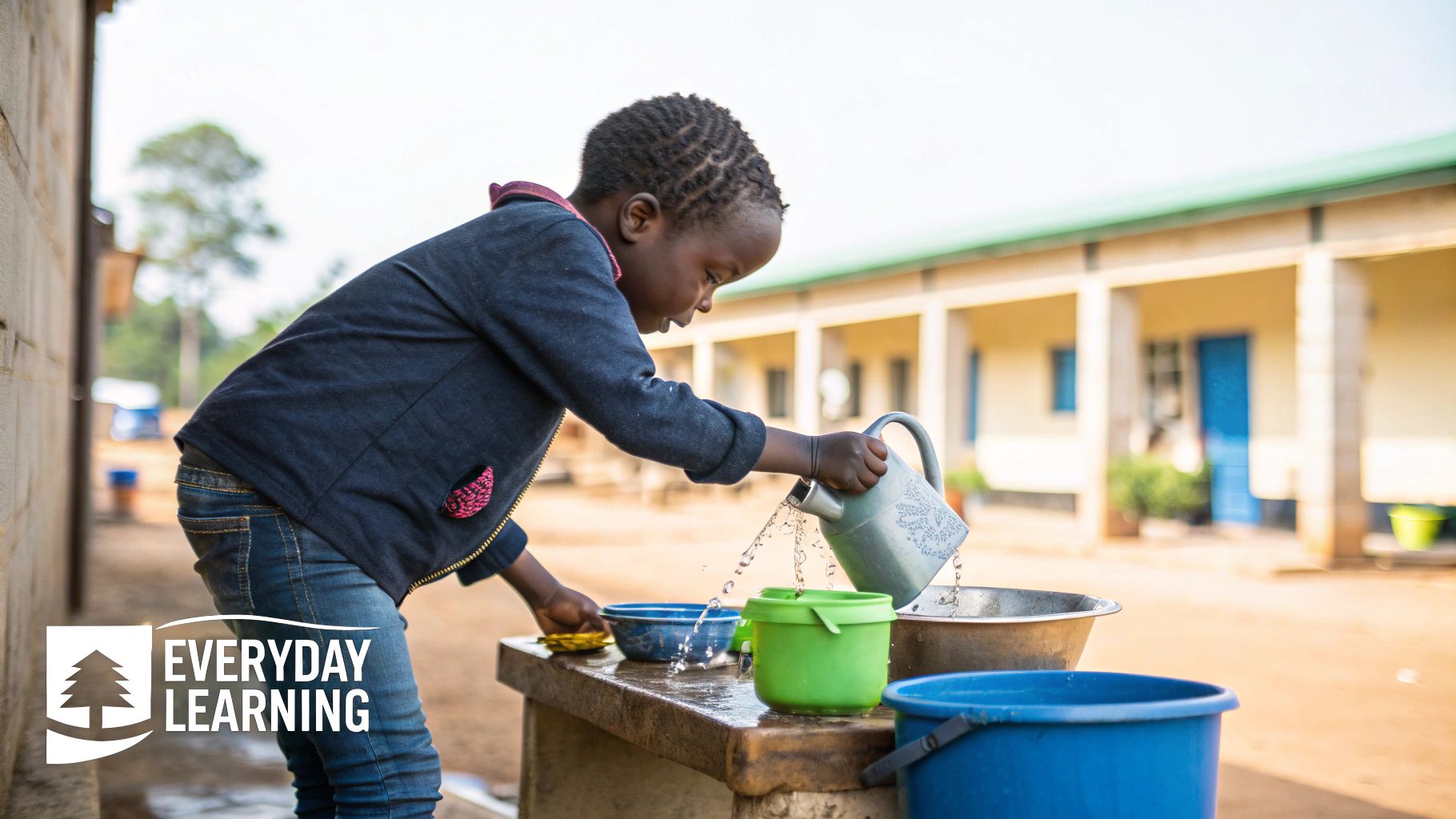
Your Guide to Montessori Education at Home
Share
Bringing the Montessori philosophy into your home isn’t about running out to buy a bunch of specific toys. It's really about a shift in perspective—seeing your child as a capable, independent little person and setting up your space to match. The goal is to prepare your home in a way that sparks their natural curiosity and lets them learn through real, hands-on activities.
Getting the Hang of Montessori at Home
Before you start rearranging furniture, it helps to really get what makes the Montessori method tick. It's less of a strict curriculum and more of a new way of thinking for you, the parent. You move from being the "teacher" who tells them what to do, to being a guide who watches, waits, and supports.
The big idea here is the prepared environment. Simply put, this means organizing your home so your child can safely do things for themselves. Think low shelves, tiny tables and chairs, and materials they can actually reach and use. This kind of setup invites them to explore without needing you to step in all the time.
The Key Ideas for Your Space
When you bring Montessori home, you're really leaning on a few core concepts that empower your child. These ideas will shape everything from the activities you set out to the way you talk with them.
- Follow the Child: Forget rigid schedules. The idea is to watch what your child is naturally drawn to and offer activities that feed that interest. Are they suddenly obsessed with pouring water from one cup to another? Great! Set up a little pouring station with a small pitcher and some cups.
- The Absorbent Mind: Dr. Maria Montessori noticed that kids under six have what she called an "absorbent mind." They just soak up everything around them without even trying. This makes your home their most important classroom, turning everyday moments into learning opportunities.
- You're the Guide, Not the Director: Your job is to set the stage, show your child how to use something, and then take a step back. You become a quiet observer, ready to help only if they truly need it. This builds their confidence and teaches them how to solve problems on their own.
“The greatest sign of success for a teacher... is to be able to say, 'The children are now working as if I did not exist.'” - Maria Montessori
This approach is all about weaving learning into the fabric of daily life. Simple chores like helping set the table or washing carrots for dinner become powerful lessons in coordination, concentration, and responsibility.
If you're looking for some easy ways to get started, there are tons of great ideas for Montessori practical life activities. For an even broader look at integrating learning at home, you might also find some inspiration in a complete guide to early childhood home learning activities. It's amazing to see how much learning potential is already hiding in your daily routines.
Creating Your Prepared Learning Environment
The real magic of Montessori at home isn’t about a specific toy or a fancy piece of equipment. It's all about the space you intentionally create for your child. We call this the “prepared environment”—a home thoughtfully arranged to nurture independence, respect your child's capabilities, and spark their curiosity.
It really just comes down to seeing your home through their eyes and making small, meaningful tweaks so it works for them. You don't need a massive overhaul or a dedicated playroom. The goal is to create an atmosphere of order, beauty, and accessibility that empowers your child to proudly say, "I can do it myself."
This infographic really captures the core philosophy behind setting up this kind of special space.

As you can see, it all starts with respecting the child's own drive. From there, you prepare their space, which then allows you to step back and simply guide their discovery.
Designing a Child-Sized World
One of the cornerstones of a prepared environment is having furniture and storage that’s actually scaled to your child. When a toddler can reach their own books, toys, and tools without asking for help, they gain a powerful sense of ownership and competence. This simple shift can dramatically cut down on frustration for both of you.
Here are a few simple places to start:
- Low, open shelves: Ditch the deep toy box where everything gets lost. Low shelving lets you display a limited, curated selection of activities in an organized way, making it much less overwhelming for your child to choose.
- Child-sized furniture: A small table and chair set instantly creates a dedicated workspace for things like drawing, puzzles, or even just having a snack. It gives them a sense of place and control. To find the right fit, you can learn more about choosing a perfect Montessori table and chair for their specific size and needs.
- Accessible hooks and baskets: Place a few low hooks by the door for their coat and a small basket for their shoes. This tiny setup turns the daily routine of coming and going into a practical lesson in independence.
By bringing the world down to their level, you're not just making things easier; you're communicating a profound message of respect for their abilities and their role in the family.
Even if you're in a small apartment, these principles still apply. A corner of the living room can become a cozy reading nook with just a few floor cushions and a forward-facing bookshelf. A low drawer in the kitchen can be designated for their own cups and plates, empowering them to help out during meal times.
Establishing Learning Zones
To bring a sense of order and purpose to your space, it helps to organize it into distinct learning areas. These "zones" don't need walls; they can be defined by something as simple as a small rug or the way a shelf is arranged.
Each area should have a clear function, which helps your child understand where to find certain activities and—just as importantly—where to put them back.
Here's a simple way to think about these areas and what you might put in them.
Key Montessori Learning Areas for the Home
| Learning Area | Core Purpose | Example Activities & Materials |
|---|---|---|
| Practical Life | Developing coordination, concentration, and independence through real-world tasks. | A small pitcher for pouring water, tongs for transferring pom-poms, a child-safe knife for slicing bananas. |
| Sensorial | Refining the senses to understand and classify the environment. | Baskets with different textured fabrics, sound cylinders (DIY with spice jars), color matching cards. |
| Language & Culture | Building vocabulary, pre-reading skills, and an understanding of the world. | Picture books displayed on a forward-facing shelf, sandpaper letters, small animal figurines to match with cards. |
The most important thing is to keep it simple. You only need a few well-chosen activities in each area to start. Based on your child's interests, you can rotate materials every week or two to keep things fresh and engaging.
This thoughtful organization is what transforms your home into a dynamic, supportive environment where learning just naturally happens.
Selecting and Presenting Montessori Materials

When you picture a Montessori classroom, those beautiful, iconic wooden materials are probably the first thing that comes to mind. They look so simple, yet every single piece is brilliantly designed to teach a specific, concrete concept.
Starting a collection for your own home, though? It can feel a little intimidating—and expensive. But it really doesn't have to be.
The secret to bringing Montessori education at home isn't about owning every material you see online. It’s about understanding the why behind them and choosing the right ones for where your child is right now. Quality over quantity is always the goal.
The Purpose Behind the Materials
True Montessori materials are very different from your average educational toy. Once you get a feel for their key characteristics, you'll be able to choose wisely, whether you're buying authentic pieces or getting creative with DIY versions.
For starters, these materials are ingeniously designed to be self-correcting. This is huge. It means your child can see their own mistake without an adult needing to step in and point it out. Think of a classic cylinder block: if one cylinder doesn’t fit, they know immediately that something needs to be re-evaluated.
Each material is also built to isolate a specific quality. The famous Pink Tower is a perfect example. All ten cubes are the exact same color, shape, and texture—the only thing that changes is their size. This design strips away all distractions, allowing the child to focus purely on the concept of dimension.
Choosing Your First Activities
You absolutely do not need a classroom's worth of materials to get started. A few carefully chosen items that genuinely spark your child’s interest will be worlds more effective than a shelf packed with things they never touch.
When you're just dipping your toes in, focus on materials that build skills in practical life and sensorial development.
Here are a few foundational ideas to get you going:
- Practical Life: You probably have these things already! A small pitcher and cups for pouring, tongs to transfer pom-poms from one bowl to another, or a child-sized broom and dustpan are fantastic starting points.
- Sensorial: Get creative here. You can make your own color tablets with paint chips from the hardware store. A basket filled with different textured fabrics (like silk, burlap, and corduroy) is a wonderful sensorial experience. Even making your own sound cylinders with small containers and rice, beans, or sand works beautifully.
The most powerful Montessori materials are often the simplest. They invite exploration not with flashing lights or sounds, but with their inherent order, beauty, and potential for discovery. Your child's engagement is the ultimate measure of a material's value.
How to Present a New Activity
The way you introduce a material is just as important as the material itself. The Montessori presentation is a slow, deliberate, and mostly silent demonstration. Your own calm, focused movements are the real instructions.
First, invite your child to the activity. Something simple like, "Would you like me to show you the Pouring Work?" is perfect. Then, carry the tray containing all the pieces to a designated workspace, like a small rug or a low table, handling it with care to model respect for the materials.
Sit right next to your child and perform the activity slowly, breaking it down into small, precise steps. Use as few words as possible; let your actions do the talking. For that pouring activity, you would slowly pick up the pitcher, aim the spout deliberately, and pour the contents carefully into the other cup.
When you're done, invite your child to have a turn. Then comes the most important part: step back. Observe them without interrupting, correcting, or even praising. This respectful observation gives them the space to practice, make their own mistakes, and eventually, achieve mastery on their own terms.
Weaving Montessori Principles into Daily Routines

True Montessori education at home isn't about a specific shelf or a scheduled "learning time." It really comes alive when you weave its principles into the natural rhythm of your family’s life. Every ordinary moment can become a powerful opportunity for growth.
The goal is to see every routine as a chance to build real independence and confidence.
This whole philosophy is incredibly practical. Instead of seeing meal prep as a chore to rush through, think of it as a lesson. Your child can wash vegetables, help pour ingredients, or stir a mixture. These simple tasks are loaded with sensory input and are fantastic for building fine motor skills.
When you invite your child to participate in the real work of the household, you're sending a powerful message: they are a valued and capable member of the family. That sense of contribution is gold for their self-esteem.
Practical Life in Every Room
Integrating these ideas doesn't require a massive overhaul. It’s more about making small, intentional tweaks to your daily flow.
-
In the Kitchen: This is the heart of practical life at home. A child who helps prepare their own snack is learning about sequencing, measurement, and coordination. Having child-safe utensils and accessible ingredients is all it takes. You might explore how a what is a learning tower can safely bring your toddler up to counter height, opening up a whole new world of participation.
-
In the Bedroom: An accessible wardrobe with just a few clothing choices empowers your child to dress themselves. This simple act of choosing an outfit is a daily exercise in decision-making.
-
Throughout the Home: Giving your child a real job, like watering a plant or wiping up a small spill, teaches them about cause-and-effect and how to care for their environment.
The most profound learning doesn't happen with a specific material, but in the context of meaningful, everyday life. When a child masters pouring their own water without spilling, the pride they feel is immense.
Modeling Grace and Courtesy
Beyond the practical tasks, daily routines are the perfect stage for modeling grace and courtesy. This is the Montessori term for teaching social skills through gentle guidance and, most importantly, your own example.
Instead of just telling your child to "say please," you model it constantly in your own interactions.
When you make a mistake, apologizing openly shows them how to take responsibility. When you greet a neighbor warmly, you're giving a real-world lesson in community and respect. These "soft skills" are every bit as crucial as academic ones.
The positive effects of this approach are well-documented. A meta-analysis of 32 studies found that Montessori children showed significant advantages in nonacademic outcomes like self-regulation and social skills—even more so than in academics.
As children get more involved in these daily activities, you can seamlessly weave in other core skills, like literacy. You can explore some effective strategies for developing reading comprehension skills that pair beautifully with hands-on learning. By turning routines into rituals of connection and growth, you’re laying the foundation for a capable, confident, and considerate human being.
Why More Parents Are Choosing Montessori at Home
If you’re looking into bringing Montessori into your home, you’re in good company. More families than ever are exploring alternatives to traditional schooling, looking for something more personal and in tune with their child's natural development.
This isn’t just about being unhappy with the current school system. Parents are actively drawn to the core ideas of Montessori: raising independent kids, sparking a genuine love for learning, and respecting children as capable little people right from the start. It’s a philosophy that just clicks with how many of us want to parent today.
The Demand Outweighs the Supply
One of the biggest real-world reasons for this shift is simple math. The popularity of Montessori has absolutely skyrocketed, but the number of schools hasn't kept up. This has created a huge bottleneck for families who are set on this path for their children.
Take the United States, for example. There are nearly 4,000 Montessori programs, but that number doesn't even come close to meeting the demand. In Baltimore, one public Montessori school had a waitlist with 1,200 names on it. A similar story unfolded in Washington D.C., where a school had over 700 students waiting for a spot.
It's a widespread problem, and this gap is what’s motivating so many parents to take matters into their own hands. If you're curious about the scale of this, you can read the full research about this educational demand to see the staggering numbers for yourself.
This shared reality has brought together thousands of parents, building a vibrant global community all focused on making Montessori at home a success.
You are not alone on this path. Knowing you're part of a larger, worldwide movement can be incredibly reassuring as you start this journey with your own family.
A Wealth of Resources at Your Fingertips
The good news? This boom in interest has led to an explosion of amazing resources. Just twenty years ago, a parent trying to do Montessori at home had little more than a few books and their own intuition to guide them.
Today, it's a completely different world. You have access to so much more:
- Online Courses and Workshops: You can find detailed programs made just for parents, breaking down big ideas into simple, actionable steps you can use right away.
- Supportive Online Communities: There are countless forums and social media groups where parents share their wins, ask for help on tough days, and cheer each other on.
- High-Quality Materials and DIY Guides: The internet is full of blogs, videos, and shops offering everything from authentic Montessori materials to clever, budget-friendly DIY alternatives.
All this information has made the Montessori philosophy accessible to everyone. It's no longer some niche, hard-to-reach alternative. It’s a well-supported, mainstream choice for families all over the world who want to give their children a thoughtful, hands-on start in life.
Common Questions About Montessori at Home
Stepping into the world of Montessori at home can feel like learning a new language. It’s exciting, but it’s totally normal to have a million questions popping up. Am I doing this right? Do I have what it takes? Let's talk through some of the most common worries that come up for parents just like you.
One of the biggest myths I hear is that you need a huge budget. The truth? You can create a beautiful, rich Montessori environment without spending a fortune on “official” materials. The whole philosophy is really about fostering independence with everyday things, not just collecting a room full of expensive wooden toys.
A simple, low shelf you find at a thrift store works just as well as a high-end designer one. Kitchen tongs for transferring pom-poms, a small pitcher for pouring practice, and a basin for water play are probably already hiding in your cupboards. It's always about the learning opportunity the item provides, not its price tag.
Do I Need Formal Training?
This question comes up all the time: "Do I have to be a certified Montessori guide?" The answer is a huge, resounding no. While formal training is a wonderful thing, it's not the magic ingredient. Your love, your patience, and your careful observation of your own child are your most powerful tools.
You are, and always will be, the number one expert on your child.
Your job isn't to be a formal instructor with a lesson plan. It's to prepare the environment and then step back, giving your child the space and freedom to explore. Think of yourself as a facilitator, not a teacher.
You've already got the key skills that make you perfectly qualified:
- Observation: Nobody knows your child's little quirks, interests, and frustrations better than you. Use that incredible knowledge to tweak activities just for them.
- Patience: You have the ability to create a calm, unhurried space where your child feels safe enough to try, maybe fail, and then try again without pressure.
- Connection: Your bond is the bedrock of it all. A secure, loving relationship is what makes all learning possible in the first place.
The success of Montessori at home isn't measured by how closely your space looks like a classroom. It's measured by how it supports your child's natural drive to learn and grow into a capable, independent little person.
What If My Child Isn't Interested?
It’s a classic scenario: you lovingly set up a beautiful new activity on the shelf, and your child walks right past it. It can feel a little disheartening, but don't worry—this is a normal and very important part of the process. It's not a failure on your part; it's just feedback from your child.
First thing's first: just watch. Is the activity maybe a little too challenging, or perhaps not challenging enough? Sometimes, the timing is simply off. There's no harm in putting the material away for a few weeks and bringing it out again later. You might be shocked at their sudden interest.
You can also try presenting it in a new way or linking it to a real-world task they already love. If they’re obsessed with helping you in the kitchen, an activity that involves scooping beans might suddenly become the most fascinating thing in the world. Always remember the core mantra: "follow the child." Their interests are your best guide, and having this flexibility is one of the greatest benefits of doing Montessori right in your own home.
At Ocodile, we believe in supporting your family's journey with furniture that's as practical as it is beautiful. Our child-safe learning towers and tables are designed to bring your child into the heart of your home, making everyday moments opportunities for connection and growth.
Explore our collection and find the perfect pieces to create your prepared environment.








